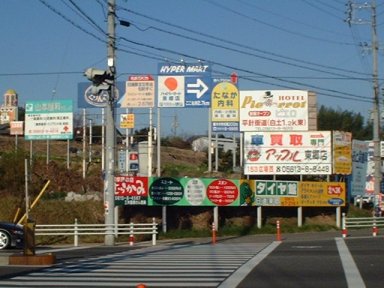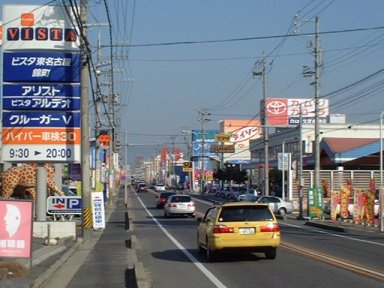Everywhere in Japan you can find abundant billboards. They are not only on shops, buildings and streets but also in rice fields and bush and on hills and mountains. Sometimes they are attached even on the wall of private houses. One can make some money by just offering idling space for billboards. An advertising company can make good money out of making billboards. An advertising client may get better business opportunities with billboards. It seems like everybody is happy so that the number of billboards increases. But it is a considerable problem that billboards are damaging scenery. Perhaps, advertising clients may say it is their bussiness when they put billboards on their property or on somewhere they pay for. But everybody shares any scenery, town or countryside, and thus everybody is responsible for the scenery.

In Europe, genellary speaking, it looks like the amount of billboards is, let's say, 1/50 of Japan. Billboards can be seen only in limited area such as airports, stations and busy section of big cities. Signs of companies and shops put on their buildings are very modest too. You can feel that their social attitude to scenery is substantially different from ours. Regulations for billboards are very mild in Japan because, presumably, nobody complain about too many billboards. I myself have never complained directly to someone responsible. You may be annoyed by messy scenery due to billboards. But there is no clear damage on you, compared to bad odor or loud noise. It feels like there is no good way to describe the damage even if you have recognized it. Thus most of the people do not take trouble to complain about messy billboards.
There have been some measures taken in order to improve scenery. For instance, in Kiso region, they came up with an agreement of contorolling too much skiing resort billboards, big enough to be recognized from several hundred meters away. They have removed those big billboards and installed new compact signs showing the direction of several skiing resorts. Another example is in Kyoto. Their local regulation about billboard limits the colors. The colors used for signs of McDonalds and ESSO are less showy than its originals. This regulation is only in Kyoto where historical townscape is their precious fortune.
One can possibly get a little more customers by putting big billboards good enough to be seen from far away. But the whole area can be damaged by such billboards and will be, soon or later, left behind as an old fashioned and bad taste place.
Controlling billboards is on its way by the people aware of the importance of scenery in tourist resort. But in case of common towns, only little measues have been taken. In Matsue, a small groupe of people who were requested to study improving townscape by the city made a proposal to remove big billboards. The city negociated with some companies to remove the house-sized billboard on the top of their buildings. But the negociation was failed because there was no legal force. It is a shame that improving town scenery can not be achieved by just negotiation.
Using many showy billboards and flags is a free competition. Quite often, you can find shops showing many flags saying "Special Sales!" or "Closing Sales!"for very long period. That's funny. But it is not creating any new demand. It is only contributing to shift the consumers from one place to the other. Too much ad on street in traditinal shopping district would rather damage townscape and cause shifting of customers to neat shopping malls where there are no billboards. Nowadays, there are many other ways to do advertising without damaging townscape. Why not use smarter way of advertising and enjoy neater townscape.
